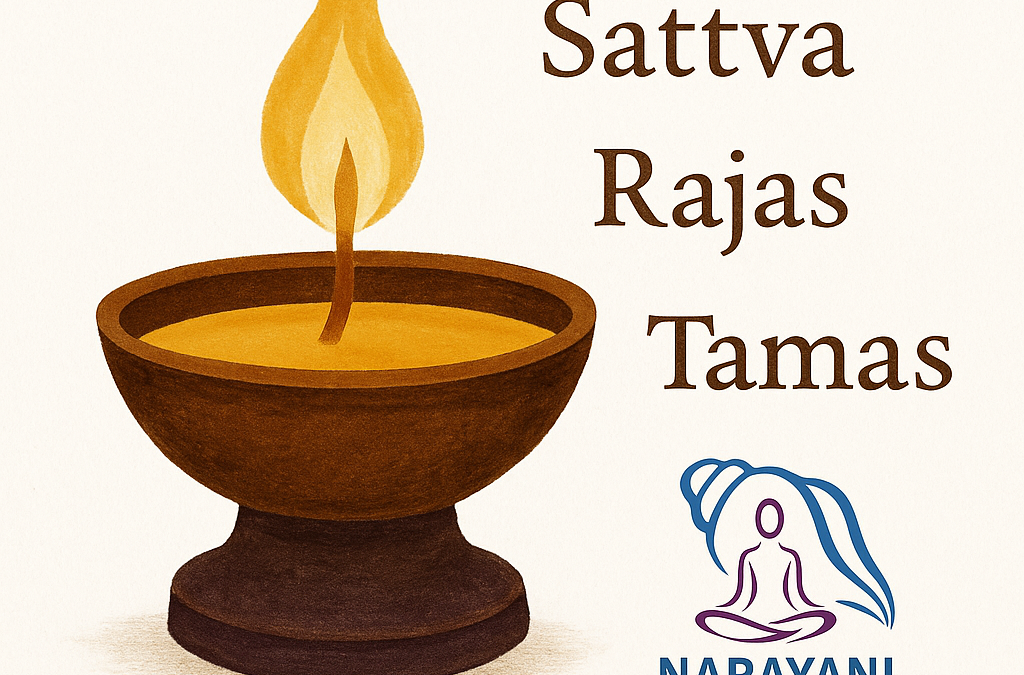In yoga therapy, we often look at how the mind, body, and spirit work together—not as separate parts, but as one connected system. One of the most insightful ways to explore this connection is through the ancient framework of the Tattvas (तत्त्व), or foundational principles of reality in Yoga and Ayurveda.
At the heart of this framework are two essential forces:
- Purusha (पुरुष): Pure consciousness. This is the inner witness—silent, steady, and unchanging. It is awareness itself, beyond the body and mind.
- Prakriti (प्रकृति): Nature or material reality. This is the creative energy behind everything we experience, including our body, thoughts, and emotions.
On their own, neither Purusha nor Prakriti creates life. But when they come together, the dance of creation begins. From this union, all of life—including our inner world—comes into being.
The Three Qualities of Nature: The Gunas (गुण)
According to Yoga and Ayurveda, Prakriti is made up of three constantly shifting qualities known as the Gunas:
- Sattva (सत्त्व) – Light, clarity, peace, and balance
- Rajas (रजस्) – Energy, movement, passion, and desire
- Tamas (तमस्) – Stillness, heaviness, darkness, and inertia
These Gunas are always present in us and around us in different combinations. They influence everything—our moods, thoughts, sleep, energy, digestion, and even the way we interact with others.
Let’s look more closely at each one.
- Sattva
(सत्त्व) – Clarity and Harmony
Sattva is the quality of inner peace, contentment, and balance. When sattva is dominant in the mind, we feel calm, centered, and clear. We are more compassionate, present, and naturally connected to our sense of purpose.
Sattva supports healing, insight, and spiritual growth. In yoga therapy, we often try to cultivate more sattva through breathwork, mindful movement, meditation, proper rest, and nourishing lifestyle choices.
In a sattvic state, you don’t feel like you’re chasing after something—you already feel whole.
2. Rajas (रजस्) – Activity and Desire
Rajas is the energy of movement, drive, ambition, and change. It pushes us to take action, to create, and to grow. This can be healthy when balanced, but when rajas dominates, the mind becomes restless, anxious, or attached to outcomes.
Rajas can fuel our goals, but too much of it may lead to burnout, emotional reactivity, or overthinking. In yoga therapy, we help regulate rajas by slowing the breath, grounding the body, and calming the nervous system.
Rajas is what gets you out of bed—but too much can keep your mind running all day and night.
3. Tamas (तमस्) – Inertia and Stability
Tamas is the energy of rest, stillness, and grounding. It allows us to sleep, slow down, and recover. But when tamasic energy builds up, it can feel like heaviness, fogginess, resistance, or even depression and confusion.
Tamas is not “bad”—we need it for restoration and boundaries. But when it dominates, it can lead to lethargy or disconnection. In yoga therapy, we gently shift tamas by using breath and movement to reawaken energy without overwhelm.
Tamas is the night’s darkness—needed for rest, but not where we want to stay all day.
We Need All Three Gunas
Sometimes we think of Sattva as “good” and the others as “bad,” but that’s not how yoga sees it. All three Gunas are necessary. They’re like ingredients in a recipe—each one has its role.
A beautiful metaphor from the Mandukya Upanishad helps us understand this:
The lamp’s base (tamas) gives it structure and stability.
The oil (rajas) is the fuel or energy that allows it to burn.
The flame (sattva) is the light and clarity we seek.
Together, they create illumination—just like the gunas work together to shape our experiences and our healing
Yoga Therapy: Working With the Gunas
Yoga therapy gives us tools to observe, balance, and shift the energies within us. We’re not trying to get rid of rajas or tamas—we’re learning to work with them wisely, and to increase sattva when needed for healing and clarity.
Through personalized practices, we support clients to:
- Calm excess rajas (anxiety, agitation, overdrive)
- Lift tamas gently (lethargy, depression, mental fog)
- Grow sattva (peace, insight, and joy)
This is a path of awareness, not perfection. Each person’s journey is unique, and each guna plays a part. Yoga teaches us not to judge these qualities, but to honor the flow of life within us, and respond with care, breath, and presence.
References
- Feuerstein, G. (2001). The Yoga Tradition: Its History, Literature, Philosophy and Practice. Hohm Press.
- Bryant, E. F. (2009). The Yoga Sūtras of Patañjali: A New Edition, Translation, and Commentary. North Point Press.
- Svoboda, R. E. (1999). Prakriti: Your Ayurvedic Constitution. Lotus Press.
- Mandukya Upanishad with Gaudapada Karika – various commentaries
- Saraswati, S. S. (1981). Tattwa Shuddhi: The Tantric Practice of Inner Purification. Bihar School of Yoga
.

